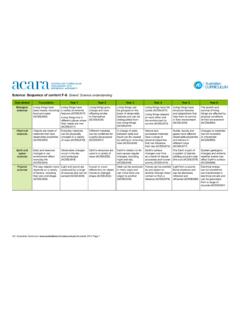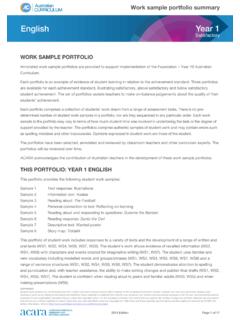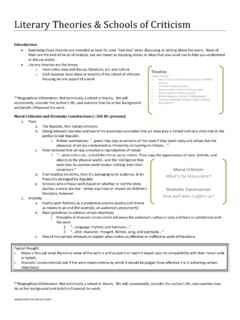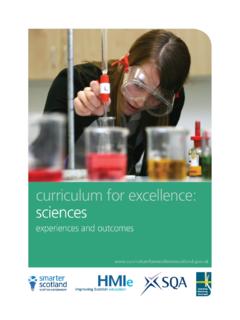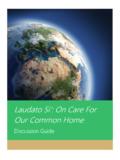Transcription of Science: Sequence of content F-6 Strand: Science …
1 Science : Sequence of content F-6 strand : Science understanding Sub- strand Foundation Year 1 Year 2 Year 3 Year 4 Year 5 Year 6. Biological Living things have Living things have Living things grow, Living things can Living things have life Living things have The growth and sciences basic needs, including a variety of external change and have be grouped on the cycles (ACSSU072) structural features survival of living food and water features (ACSSU017) offspring similar basis of observable Living things depend and adaptations that things are affected by (ACSSU002) Living things live in to themselves features and can be on each other and help them to survive physical conditions different places where (ACSSU030) distinguished from the environment to in their environment of their environment their needs are met non-living things survive (ACSSU073) (ACSSU043) (ACSSU094).
2 (ACSSU211) (ACSSU044). Chemical Objects are made of Everyday materials Different materials A change of state Natural and Solids, liquids and Changes to materials sciences materials that have can be physically can be combined for between solid and processed materials gases have different can be reversible observable properties changed in a variety a particular purpose liquid can be caused have a range of observable properties or irreversible (ACSSU003) of ways (ACSSU018) (ACSSU031) by adding or removing physical properties and behave in (ACSSU095). heat (ACSSU046) that can influence different ways their use (ACSSU074) (ACSSU077). earth and Daily and seasonal Observable changes earth 's resources are earth 's rotation on its earth 's surface The earth is part of Sudden geological space changes in our occur in the sky used in a variety of axis causes regular changes over time a system of planets changes and extreme sciences environment affect and landscape ways (ACSSU032) changes, including as a result of natural orbiting around a star weather events can everyday life (ACSSU019) night and day processes and human (the sun) (ACSSU078) affect earth 's surface (ACSSU004) (ACSSU048) activity (ACSSU075) (ACSSU096).
3 Physical The way objects move Light and sound are A push or a pull Heat can be produced Forces can be exerted Light from a source Electrical energy sciences depends on a variety produced by a range affects how an object in many ways and by one object on forms shadows and can be transferred of factors, including of sources and can be moves or changes can move from one another through direct can be absorbed, and transformed in their size and shape sensed (ACSSU020) shape (ACSSU033) object to another contact or from a reflected and electrical circuits and (ACSSU005) (ACSSU049) distance (ACSSU076) refracted (ACSSU080) can be generated from a range of sources (ACSSU097). Australian Curriculum December 2015 Page 1. Science : Sequence of content : F-6 strand : Science as a human endeavour Sub- strand Foundation Year 1-2 Year 3-4 Year 5-6. Nature and Science involves observing, asking Science involves observing, asking Science involves making predictions and Science involves testing predictions development questions about, and describing questions about, and describing describing patterns and relationships by gathering data and using evidence of Science changes in, objects and events changes in, objects and events (ACSHE050) & (ACSHE061) to develop explanations of events and (ACSHE013) (ACSHE021) & (ACSHE034) phenomena and reflects historical and cultural contributions (ACSHE081) &.
4 (ACSHE098). Use and People use Science in their daily Science knowledge helps people to Scientific knowledge is used to solve influence of lives, including when caring for understand the effect of their actions problems and inform personal and Science their environment and living things (ACSHE051) & (ACSHE062) community decisions (ACSHE083) &. (ACSHE022) & (ACSHE035) (ACSHE100). Australian Curriculum December 2015 Page 2. Science : Sequence of content : F-6 strand : Science inquiry skills Sub- strand Foundation Year 1-2 Year 3-4 Year 5-6. Questioning Pose and respond to questions about Pose and respond to questions, and With guidance, identify questions With guidance, pose clarifying questions and predicting familiar objects and events (ACSIS014) make predictions about familiar objects in familiar contexts that can be and make predictions about scientific and events (ACSIS024) & (ACSIS037) investigated scientifically and make investigations (ACSIS231) & (ACSIS232).
5 Predictions based on prior knowledge (ACSIS053) & (ACSIS064). Planning and Participate in guided investigations and Participate in guided investigations With guidance, plan and conduct Identify, plan and apply the elements conducting make observations using the senses to explore and answer questions scientific investigations to find answers of scientific investigations to answer (ACSIS011) (ACSIS025) & (ACSIS038) to questions, considering the safe use questions and solve problems using of appropriate materials and equipment equipment and materials safely and Use informal measurements to collect (ACSIS054) & (ACSIS065) identifying potential risks (ACSIS086) &. and record observations, using digital (ACSIS103). technologies as appropriate (ACSIS026) Consider the elements of fair tests and & (ACSIS039) use formal measurements and digital Decide variables to be changed and technologies as appropriate, to make measured in fair tests, and observe and record observations accurately measure and record data with accuracy (ACSIS055) & (ACSIS066) using digital technologies as appropriate (ACSIS087) & (ACSIS104).
6 Processing Engage in discussions about Use a range of methods to sort Use a range of methods including tables Construct and use a range of and analysing observations and represent ideas information, including drawings and and simple column graphs to represent representations, including tables and data and (ACSIS233) provided tables through discussion, data and to identify patterns and trends graphs, to represent and describe information compare observations with predictions (ACSIS057) & (ACSIS068) observations, patterns or relationships (ACSIS027) & (ACSIS040) Compare results with predictions, in data using digital technologies as suggesting possible reasons for findings appropriate (ACSIS090) & (ACSIS107). (ACSIS215) & (ACSIS216) Compare data with predictions and use as evidence in developing explanations (ACSIS218) & (ACSIS221). Evaluating Compare observations with those of Reflect on investigations, including Reflect on and suggest improvements others (ACSIS213) & (ACSIS041) whether a test was fair or not to scientific investigations (ACSIS091) &.
7 (ACSIS058) & (ACSIS069) (ACSIS108). Communicating Share observations and ideas Represent and communicate Represent and communicate Communicate ideas, explanations (ACSIS012) observations and ideas in a variety of observations, ideas and findings using and processes using scientific ways (ACSIS029) & (ACSIS042) formal and informal representations representations in a variety of ways, (ACSIS060) & (ACSIS071) including multi-modal texts (ACSIS093). & (ACSIS110). Australian Curriculum December 2015 Page 3. Science : Sequence of content : 7-10 strand : Science understanding Sub- strand Year 7 Year 8 Year 9 Year 10. Biological Classification helps organise the diverse Cells are the basic units of living things;. Multi-cellular organisms rely on Transmission of heritable characteristics sciences group of organisms (ACSSU111) they have specialised structures and coordinated and interdependent internal from one generation to the next involves functions (ACSSU149) systems to respond to changes to their DNA and genes (ACSSU184).
8 Interactions between organisms, including the effects of human activities Multi-cellular organisms contain systems environment (ACSSU175) The theory of evolution by natural can be represented by food chains and of organs carrying out specialised Ecosystems consist of communities of selection explains the diversity of living food webs (ACSSU112) functions that enable them to survive interdependent organisms and abiotic things and is supported by a range of and reproduce (ACSSU150) components of the environment; matter scientific evidence (ACSSU185). and energy flow through these systems (ACSSU176). Chemical Mixtures, including solutions, contain Properties of the different states of All matter is made of atoms that are The atomic structure and properties of sciences a combination of pure substances that matter can be explained in terms of the composed of protons, neutrons and elements are used to organise them in can be separated using a range of motion and arrangement of particles electrons; natural radioactivity arises the Periodic Table (ACSSU186).
9 Techniques (ACSSU113) (ACSSU151) from the decay of nuclei in atoms Different types of chemical reactions are Differences between elements, (ACSSU177) used to produce a range of products compounds and mixtures can be Chemical reactions involve rearranging and can occur at different rates described at a particle level (ACSSU152) atoms to form new substances; during a (ACSSU187). Chemical change involves substances chemical reaction mass is not created or reacting to form new substances destroyed (ACSSU178). (ACSSU225). Chemical reactions, including combustion and the reactions of acids, are important in both non-living and living systems and involve energy transfer (ACSSU179). earth and Predictable phenomena on earth , Sedimentary, igneous and metamorphic The theory of plate tectonics explains The universe contains features including space including seasons and eclipses, are rocks contain minerals and are formed global patterns of geological activity and galaxies, stars and solar systems, sciences caused by the relative positions of the by processes that occur within earth continental movement (ACSSU180) and the Big Bang theory can be used sun, earth and the moon (ACSSU115) over a variety of timescales (ACSSU153) to explain the origin of the universe Some of earth 's resources are (ACSSU188).
10 Renewable, including water that cycles Global systems, including the carbon through the environment, but others are cycle, rely on interactions involving the non-renewable (ACSSU116) biosphere, lithosphere, hydrosphere and atmosphere (ACSSU189). Physical Change to an object's motion is caused Energy appears in different forms, Energy transfer through different Energy conservation in a system can be sciences by unbalanced forces, including earth 's including movement (kinetic energy), mediums can be explained using wave explained by describing energy transfers gravitational attraction, acting on the heat and potential energy, and energy and particle models (ACSSU182) and transformations (ACSSU190). object (ACSSU117) transformations and transfers cause The motion of objects can be described change within systems (ACSSU155) and predicted using the laws of physics (ACSSU229).





